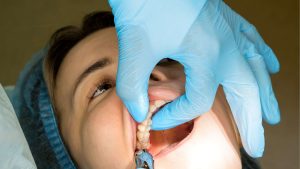In this article, the Irving orthodontist will help us understand all about overbite and its effective management.
What causes overbite?
The causes of overbite can be divided into two main categories: skeletal and dental.
Skeletal causes:
- Genetics: Inherited facial structure and jaw alignment.
- Abnormal jaw growth: Uneven growth of the upper and lower jaws.
- Craniofacial syndromes: Conditions like Crouzon syndrome or Apert syndrome.
Dental causes:
- Thumb sucking or pacifier use: Prolonged sucking habits push the upper teeth forward.
- Tooth loss: Missing teeth can cause adjacent teeth to shift and create an overbite.
- Poor oral habits: Tongue thrusting, nail-biting, or other habits can contribute to overbites.
- Misaligned teeth: Crowded or crooked teeth can lead to an overbite.
- Supernumerary teeth: Extra teeth can cause overcrowding and overbites.
- Impacted teeth: Teeth that don’t erupt properly can lead to overbites.
- Orthodontic treatment: Inadequate or incomplete treatment can result in overbites.
Other factors that can contribute to overbites include:
- Age: Overbites can develop or worsen with age.
- Ethnicity: Some ethnic groups are more prone to overbites.
- Environmental factors: Prolonged use of bottles or pacifiers.

What are the symptoms of overbite?
The symptoms of overbite may include:
- Visible overlap of upper teeth over lower teeth
- Difficulty biting or chewing food
- Wear on teeth, especially the front teeth
- Jaw pain or discomfort
- Clicking or popping of the jaw joint (TMJ)
- Difficulty speaking or enunciating words
- Aesthetic concerns, such as a “gummy” smile
- Increased risk of tooth decay and gum disease
- Headaches or facial pain
- Difficulty closing the mouth or lips
- Breathing difficulties (in severe cases)
- Sleep apnea or snoring (in severe cases)
- TMJ disorders or temporomandibular joint pain
- Tooth sensitivity or pain
- Chewing or biting difficulties
How is overbite treated?
Treatment for overbite depends on the severity and cause of the condition. Options include:
Orthodontic treatment:
– Braces or clear aligners to move teeth into the proper position
– Retainers to maintain alignment
Tooth extraction:
– Removing teeth to create space for proper alignment
Bite adjustment:
– Adjusting the bite to improve alignment
Jaw surgery:
– Correcting the jaw position to address skeletal overbites
Orthognathic surgery:
– Correcting the jaw alignment and facial structure
Dental restorations:
– Crowns, veneers, or bonding to improve tooth shape and alignment
Habit correction:
– Stopping thumb sucking or pacifier use
– Correcting tongue thrusting or other habits
Early treatment:
– Interceptive orthodontics for children to address developing overbites
Combination therapy:
– Using multiple treatments simultaneously for optimal results
What are the consequences of untreated overbite?
Here is a comprehensive list of consequences of untreated overbites:
- Tooth wear and tear
- Increased risk of tooth decay
- Gum disease and periodontal disease
- Jaw pain and TMJ disorders
- Difficulty speaking and eating
- Aesthetic concerns and low self-esteem
- Sleep apnea and snoring
- Headaches and facial pain
- Chewing and digestion issues
- Increased risk of tooth loss
- Bite collapse
- Reduced oral function
- Difficulty closing the mouth or lips
- Breathing difficulties
- Orthodontic treatment challenges
- Increased risk of dental work (e.g., fillings, crowns)
- Impact on overall health and well-being
- Difficulty with oral hygiene
- Increased risk of dental emergencies
- Long-term facial structure changes
An overbite is a common orthodontic issue that can lead to various problems if left untreated. By understanding the causes, symptoms, and treatment options, individuals can take steps to correct their overbite and achieve a healthier, more confident smile. If you suspect you or your child has an overbite, consult an orthodontist for a professional evaluation and personalized treatment plan.







More Stories
Healing Through Faith and Understanding: The Role of a Trauma-Informed Life Coach
Impacted Molar Extraction: Understanding the Procedure and Its Benefits
PCL Thread Lift – Why It’s Better Than Other Threads?